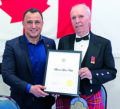Columns » Opinion
FRONT PORCH PERSPECTIVE: Book Review – “Operation Paperclip”
January 12, 2017 · 0 Comments
By Stephen Somerville
I was planning to write – on behalf of a friend – about those people who think it is okay to put their refuse at the edge of the road days ahead of garbage day. But, that will have to wait.
I know that Christmas has just passed and your wallet has not recovered yet, but I have a birthday gift idea for book lovers.
The name of the book is “Operation Paperclip – The Secret Intelligence Program that Brought Nazi Scientists to America.”
The book, written by Annie Jackobsen, has been a national best seller in the United States.
The book is about the U.S Government’s clandestine actions during and at the end of World War II to secure the drawings, technology and people associated with Nazi Germany’s rocket, biological and chemical weapons programs.
I had heard about Operation Paperclip from previous books, but the author does a fantastic job in taking us behind the scenes and through the corridors of power, as the U.S. military and State Department fight over whether these former Nazi scientists should be allowed to enter the U.S.
I had originally been led to believe that Operation Paperclip was simply the spiriting out of Germany of those scientists and engineers that were associated with the V-1 rocket program, but the program was about much more.
Operation Paperclip also involved the search for atomic, biological and chemical weapons.
The Americans wanted to know what type of weapons the Germans had been developing in the hope that they could use these on the Japanese.
Remember, the hostilities with the Germans ended in early May 1945 and the Americans were preparing for a full scale invasion of Japan in the fall of 1945.
U.S. General Douglas McArthur was planning an invasion using 1 million troops and the casualty estimates were as high 25%; so the Americans were looking for any advantage.
In the end, as we know, the invasion of Japan was not required. The U.S dropped atomic bombs on Hiroshima and Nagasaki, which ended the war.
The Americans discovered that the Nazis had not found the ability to split the atom, however, they had developed a biological weapon that was so powerful that a drop of it on the skin would have killed a person in seconds.
The Nazis had produced a ton of this chemical agent and were preparing to put this in their V-1 and new V-2 rockets.
After the war, General Eisenhower, Leader of the Allied Forces in Europe during the time said that if the Nazis had this capacity prior to D-Day, June 6, 1944, then the outcome of the war could have been much different.
The book focuses on twelve German men (all dead today) who were scientists, engineers or businessman involved in the rocket, biological or chemical warfare programs of the Third Reich.
The book also details the horrible testing and experiments that were conducted on prisoners at the concentration camps in Germany.
What I found most intriguing was the interplay between the U.S. Military and the U.S. State Department. The Military was convinced that there would be a clash for survival with the Russians and they were in a race with them to acquire the biological and chemical weapons to fight this next war.
The State Department did not want to allow into the country former Nazis who had either directly or indirectly participated in the horrendous experiments at the concentration camps.
However, in the name of national security the State Department was overruled in a number of cases, and many former Nazi scientists and engineers were given visas to America.
In the ensuing years after World War II, many of these men were prominent team members of the U.S. space program.
I am not yet finished the book but it is a fascinating read and the book is hard to put down.
I would recommend it for anyone who appreciates technology, biography, history and national security issues.
Stephen can be contacted at stephengsomerville@yahoo.com











